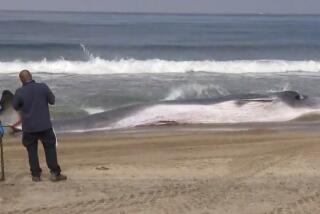Whale Turns Upstream, Is Left Alone
RIO VISTA, Calif. — Federal officials abruptly halted a campaign to save a humpback whale in the Sacramento River on Monday, after the wayward mammal was discovered back upstream near this little town shortly after dawn.
Faced with its first serious setback after three days of success in driving the animal downstream, the National Marine Fisheries Service called off the herding operation, sent dozens of volunteers home and left the whale to swim up and down the river as it pleases.
“We’re suspending this immediate operation as of today,” announced Jim Lecky, a wildlife biologist with the agency, which has jurisdiction over the whale.
The decision disappointed some members of the rescue team, who would like to see the agency move more aggressively to save “Humphrey,” as the whale has become known.
Watched by Boaters
Throughout the day, several boat crews observed the 40-foot whale’s course as it swam back and forth near Decker Island. As usual, hundreds of people lined the riverbank to view the popular cetacean.
As darkness neared, scientists tried and failed to attach a barbed satellite transmitter to the 40-ton animal. They will attempt again today to attach the device, which could make it possible later to herd the whale more effectively, especially at night.
However, Lecky said the agency has no plans to begin such an effort. On Thursday, which will be three weeks after the whale made a wrong turn into San Francisco Bay as it migrated southward, the agency plans to convene a meeting of scientific experts to discuss what might be done next, he said.
When the whale crossed under the Golden Gate Bridge on Oct. 10, the National Marine Fisheries Service, one of whose functions is to protect endangered marine species, was initially inclined to leave the giant creature alone and let nature take its course.
Volunteers from throughout Northern California tried to help the animal return to sea, but the agency stepped in and halted the effort.
Then, bowing to political pressure and the wishes of whale-lovers throughout the state, the agency authorized a campaign to herd the animal to saltwater.
On Friday, the combined federal, state, county and volunteer team freed the whale from Shag Slough, a shallow, dead-end channel about 60 miles from the ocean, where the animal had been trapped for nearly a week behind a small bridge.
On Saturday, boats herded the whale under the Rio Vista drawbridge, the second major barrier. And on Sunday, a fleet of about 25 boats drove the animal past Pittsburg, to a point about 15 miles down river from Rio Vista and 35 miles from the Golden Gate Bridge.
The whale drive was set to begin again early Monday, when the animal was discovered back up the river near Rio Vista in about the same place the herding operation had begun the day before.
“I’m a little bit disappointed,” Lecky said at a press conference in Pittsburg. “I wish we could have gotten him out of here.”
Positive View
The biologist refused to admit defeat, however, saying, “We’ve had a real successful operation. I think this whale can get out . . . from here.”
Debbie Ferrari, a marine biologist who helped lead the early rescue effort, agreed that the animal could benefit from a day without the stress of being herded downstream.
“I think it’s good to give the animal one day of rest and observe whether he goes north or south,” she said.
She said she feared, however, that the animal may die if it is left to its own devices in freshwater.
“I don’t think it’s a good decision to totally suspend it (the rescue).”
Before the Marine Fisheries Service would be willing to resume the rescue operation, a number of problems will have to be solved, according to Lecky and other leaders of the campaign.
Continuous Effort
To drive the whale from the river near Rio Vista to saltwater, about 30 miles away, would take at least 24 hours of continuous prodding.
So far, driving the disoriented leviathan at night has proved impossible, without having a homing device to track the huge creature in the darkness. Furthermore, the whale appears to be growing less sensitive to the noise of banging pipes, which initially had proved effective in driving it downstream.
“We drove him as hard as we could yesterday,” Lecky said. “We were as aggressive as we could get. We managed to drive him 14 miles. It took us all day to do that.”
Unless there is some likelihood of moving the whale into saltwater, Lecky said, it would not be beneficial to continue placing it under the stress caused by the herding operation.
“If we could keep it up through the night, we could probably get him out of here,” he said.
More to Read
Sign up for Essential California
The most important California stories and recommendations in your inbox every morning.
You may occasionally receive promotional content from the Los Angeles Times.








